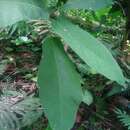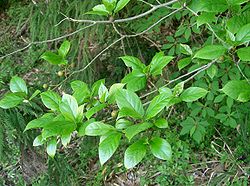zh-TW
在導航的名稱


Ficus erecta (syn. Ficus beecheyana), the Japanese fig, is a species of flowering plant in the family Moraceae.[3] It is found in the eastern Himalayas, Assam, Bangladesh, Vietnam, southern China, Taiwan, Jeju Island of South Korea, the Ryukyu Islands, and Japan.[2] A deciduous (or semideciduous) shrub or small tree from 2 to 7 m (7 to 23 ft) in height, it is found alongside streams.[4] Said to be dioecious, it has small fruit that are 1.0 to 2.5 cm (0.4 to 1.0 in) in diameter, and quite sweet.[4][5]
The fruit are eaten by local peoples. Its bark fibers can be used to make paper, and it is occasionally planted as an ornamental.[4][5] It is highly resistant to Ceratocystis fimbriata, which causes Ceratocystis canker in the common fig Ficus carica, so its genome has been sequenced.[6]
Jōmon period basket made from Ficus erecta some 8,000 years ago
Ficus erecta (syn. Ficus beecheyana), the Japanese fig, is a species of flowering plant in the family Moraceae. It is found in the eastern Himalayas, Assam, Bangladesh, Vietnam, southern China, Taiwan, Jeju Island of South Korea, the Ryukyu Islands, and Japan. A deciduous (or semideciduous) shrub or small tree from 2 to 7 m (7 to 23 ft) in height, it is found alongside streams. Said to be dioecious, it has small fruit that are 1.0 to 2.5 cm (0.4 to 1.0 in) in diameter, and quite sweet.
Ficus erecta là một loài thực vật có hoa trong họ Moraceae. Loài này được Thunb. mô tả khoa học đầu tiên năm 1786.[1]
Ficus erecta là một loài thực vật có hoa trong họ Moraceae. Loài này được Thunb. mô tả khoa học đầu tiên năm 1786.
矮小天仙果(学名:Ficus erecta),又名牛乳榕、牛乳房、牛乳婆、牛乳甫、假枇杷、毛天仙果,为桑科榕属下的一个种。分佈於臺灣全島平地、蘭嶼、中國大陸華南、琉球及馬來西亞。[1]
|access-date=中的日期值 (帮助)
|access-date=中的日期值 (帮助)
 分類(APG III) 界 : 植物界 Plantae 階級なし : 被子植物 angiosperms 階級なし : 真正双子葉類 eudicots 階級なし : コア真正双子葉類 core eudicots 階級なし : バラ類 rosids 階級なし : 真正バラ類I eurosids I 目 : バラ目 Rosales 科 : クワ科 Moraceae 連 : イチジク連 Ficeae 属 : イチジク属 Ficus 種 : イヌビワ F. erecta 学名 Ficus erecta
分類(APG III) 界 : 植物界 Plantae 階級なし : 被子植物 angiosperms 階級なし : 真正双子葉類 eudicots 階級なし : コア真正双子葉類 core eudicots 階級なし : バラ類 rosids 階級なし : 真正バラ類I eurosids I 目 : バラ目 Rosales 科 : クワ科 Moraceae 連 : イチジク連 Ficeae 属 : イチジク属 Ficus 種 : イヌビワ F. erecta 学名 Ficus erectaイヌビワ(犬枇杷、学名: Ficus erecta)は、クワ科イチジク属の落葉小高木。別名イタビ、姫枇杷。
果実(正確にはイチジク状果という偽果の1種)がビワ[2]に似ていて食べられるが、ビワに比べ不味であることから「イヌビワ」の名がある。
高さは5mくらいまで。
葉は狭い倒卵形から長楕円形、基部は少し心形か丸まる。葉質は薄くて草質、表面は滑らかかあるいは短い毛が立っていてざらつく。変異が多く、海岸沿いでは厚い葉のものも見ることがある。ごく幅の狭い葉をつけるものをホソバイヌビワ (var. sieboldii (Miq.) King)、葉面に毛の多いものをケイヌビワ (var. beecheyana (Hook. et Arn.) King) というが、中間的なものもある。
雌雄異株で、花期は4〜5月頃。
イヌビワの花序には、他の多くのイチジク属植物と同様に、イチジクコバチ科(英語版)のハチ(イヌビワコバチ(セブアノ語版))が寄生する。雄花序の奥側には雌花に似た「虫えい花」(花柱が短く、不妊)があり、これにハチが産卵する。幼虫は虫えい花の子房が成熟して果実状になるとそれを食べ、成虫になる。初夏になると雌成虫は外に出るが、雄成虫は花序の中で雌成虫と交尾するだけで一生を終える。雌成虫は雄花序の出口付近にある雄花から花粉を受け、この頃(初夏)に開花する雌花序に入った際には授粉をするが、ここでは子孫を残せず、雄花序に入ったものだけが産卵し、翌年春にこれが幼虫になる。このように、イヌビワの授粉には寄生蜂が必要であり、イヌビワと寄生蜂は共生しているということができる。
日本(本州関西以西、四国、九州、沖縄)の海岸や沿海の山地に自生する。
なお、イチジク属のものには熱帯性のものが多く、本種は落葉性を獲得したため、暖温帯まで進出できたものと考えられる。本種はイチジク属の木本としては本土で最も普通に見られるため、南西諸島などに分布する同属のものには「○○イヌビワ」という本種に比した名を持つものが多い。